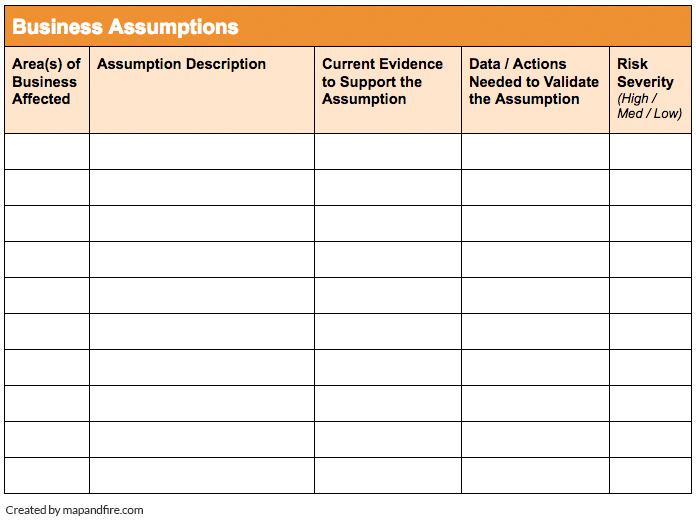
“It ain’t what you don’t know that gets you into trouble. It’s what you know for sure that just ain’t so.”
(The Big Short attributes this quote to Mark Twain, but research says it may belong to Josh Billings — despite any assumptions made, it’s still relevant)
Every new business is built on a series of assumptions. If someone tried to perfectly define every variable that affects a business upfront, they’d never get started. You have to make some assumptions in order to move forward.
So, assumptions in business are necessary and they aren’t inherently bad. But they can cause trouble if they go ignored, or if they’re simply accepted as truth. To avoid getting tripped up, you need a way to recognize, test, and validate (or invalidate) your assumptions.
Fortunately, the process is pretty simple. It goes like this:
- Create assumptions (i.e. make our best guesses about the areas that affect our business, and operate as though the guesses are true)
- Gather data to validate or invalidate those assumptions
- Adapt accordingly, repeating the process for new assumptions that arise
And the question isn’t so much whether you’ll follow those steps, because we all follow them to some degree whether we recognize it or not. The question is whether you’re an active participant in those steps.
One way of going through this process is to stop at Step 1. In other words, you make assumptions about what will work, move forward, and hope for the best. Maybe it works out, maybe not. In either case, you probably won’t know why. Quite a few businesses operate solely on this “leap of faith” approach.
A better way to deal with assumptions is to proactively drag them out into the light and address them in a systematic way.
This process takes real effort. One of the first challenges is that we usually don’t recognize just how many assumptions we’ve made — and once we start uncovering them, it can be scary to see just how many there are.

Where Do Assumptions Come From?
The quote at the top of the article describes two sources of fuel for our assumptions:
- Information we don’t know.
- Information we think we know, but actually don’t.
The first source is a little more straightforward as these are things we readily admit to not knowing. These are the factors that we openly discuss and actively work to prove out.
The second source is more slippery because it creates assumptions we don’t even recognize as assumptions. This source is powered by things like internal biases, past experience, lack of experience, or just some good old fashioned ego.
Despite being so slippery though, those types of assumptions can still be uncovered if you apply rigorous, honest analysis.
Here are some places you can start looking for both the obvious and less obvious assumptions you’ve made.
Where Are Those Assumptions Hiding?
To figure out where your assumptions are hiding out, you need to review the different areas of your business in a structured and systematic way.
To do this, you’ll need to walk through all the key elements of your business. This could involve reviewing a business plan or pitch deck, using a tool like the Business Model Canvas, or analyzing the different departments of your company.
At Map & Fire we developed The Brand Guidebook process to help business owners gain a deep understanding of your brand’s vision, positioning, and marketing.
The following are some examples of assumptions business owners could make in each of those areas. This is far from comprehensive, but it quickly highlights the variety of elements you should consider.
As you read through this list, take two steps with each statement:
- State each line as though it were true by starting with “We know…” (e.g. “We know…Our company’s vision is clear.”)
- Then ask yourself how you know that to be true, by filling in the statement “because…”. Be extremely concrete with the evidence you have to validate the truth of the statement. Where is it documented? How has it been tested? Was it tested recently?
If you take pause on a particular item because you don’t have concrete evidence for its validity, mark it down as an assumption that needs attention.
Purpose (“We know… because…”):
- Our company’s vision is clear.
- Our team understands and embodies our core values.
- Our long term goals and objectives cohesively support our vision.
Customers (“We know… because…”):
- Who our target customer is.
- What our target customers’ most important needs and pain points are.
- The functional, emotional, and aspirational drivers our customers value in a solution for those needs.
Competition (“We know… because…”):
- Who or what also satisfies our target customers’ needs.
- How those competitors satisfy those needs better or worse than we do.
- Where we have opportunities or challenges in how we satisfy those needs relative to the competition.
- How to quantify those opportunities and challenges to refine our competitive position.
Offering (“We know… because…”):
- What our team’s strengths and weaknesses are.
- What features of our offering best align with what our customers value.
- Our value proposition is clear.
- Where we have true competitive advantages in creating our offering (i.e. we can charge more than the competition, or it costs us less than the competition to execute).
Brand (“We know… because…”):
- What our mission is.
- What qualities and characteristics our brand embodies.
- What our tone of voice is.
- How our visual identity reinforces the strategy of our brand.
- How our visual identity is unique within the competitive landscape.
Marketing (“We know… because…”):
- The keywords that offer the best opportunity for connecting with our customers.
- Which messages best address the psychological forces attracting or blocking customers to use our offering.
- Which marketing channels our customers use most.
As you work through these areas, you can collect these assumptions using a basic spreadsheet format:
NOTE: We have this spreadsheet as a free google doc template here.

Once you have the assumptions collected, the next step is to start validating.
Sorting and Testing Your Assumptions
Because there are so many areas where assumptions can be made, it’s important to prioritize them according to the level of risk they pose. The key question to ask yourself is:
What are the assumptions you’ve made about your business that, if wrong, would most impact your ability to succeed?
The riskier they are, the higher they need to be on your to-do list. (And, unfortunately, the more tempting they might be to ignore — but that’s exactly why we do this!).
For example, if you find you’ve made an incorrect assumption about your customers’ needs, the rest of your assumptions may not even matter. You may have to consider a pivot in your business.
And that’s what the testing portion of this process is all about. In order to make decisions, you’ll need to gather these assumptions and then test them through experiments.
Experiments allow you to gather the necessary data to actually validate these critical facts about your business. It’s about making the leap from thinkingsomething might be true to really knowing it, and having the evidence to back up your decisions.
You can read more about the brand experimentation process here.
And while the prospect of collecting all this information and testing it may seem intimidating or a little scary, consider the alternative: You could spend mountains of time and money building something only to find out nobody wants it.
That’s why capturing and testing your assumptions isn’t just a good idea, it could be the difference between thriving and becoming another business statistic.
Start Uncovering Your Assumptions Today
If you want some help defining the direction of your business and start identifying some assumptions, you can download our free Big Picture Strategy Workbook.
And if you’re ready for something more in depth and more hands-on, contact us through our website and we can do a free consultation.


